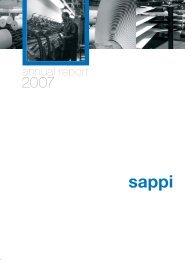2012 Integrated report - Sappi
2012 Integrated report - Sappi
2012 Integrated report - Sappi
You also want an ePaper? Increase the reach of your titles
YUMPU automatically turns print PDFs into web optimized ePapers that Google loves.
29.2 Financial instruments continued<br />
Hedge accounting<br />
1. Fair value hedges<br />
In June 2009, a partial-term fair value hedging instrument that hedged the unsecured notes due <strong>2012</strong> and unsecured notes due 2032<br />
was sold. The gain on the hedging instrument was capitalised to the bonds and, in accordance with IAS 39 Financial Instruments:<br />
Recognition and Measurement, was amortised over the shorter of the expected life of the bonds or the hedging instrument. The<br />
unsecured notes due <strong>2012</strong> were redeemed in fiscal 2011 which resulted in the related unamortised gain related to those notes being<br />
released to profit or loss. In fiscal <strong>2012</strong>, the remaining unamortised gain of US$3 million was released to profit or loss as the original term<br />
of the hedging instrument had expired.<br />
In April 2011, <strong>Sappi</strong> Papier Holding issued US$350 million senior secured notes due 2021. The fixed rates of the bonds were swapped<br />
into six-month US Dollar LIBOR rates set in advance. The hedge qualifies for fair value hedge accounting as all the material terms of the<br />
swaps match the terms of the underlying bond.<br />
The bonds and the swaps are revalued on a monthly basis and show movements in line with changing market conditions. All market<br />
movements are reversed over time and the fair value of the bonds will at maturity revert to the nominal amount of the bonds. As the<br />
swaps were contracted at the same time as the issuance of the bonds, the designated benchmark value of the bonds corresponds to the<br />
nominal amount. The only income statement impact will be any residual ineffectiveness, which is not expected to be material. The initial<br />
mark-to-market value of the swaps of US$2.1 million reflects the pricing of the swap and the difference between the mid-market curve<br />
that was used to mark-to-market, and the effective market curve at which the swaps were contracted.<br />
<strong>Sappi</strong> uses the REVALHedgeRx module (‘REVAL’), a web-based application that provides treasury and risk management solutions.<br />
The application is supplied by Reval.Com, Inc., a financial technology company based in New York and is used to assess both the<br />
prospective and the retrospective effectiveness of a fair value hedge relationship.<br />
The statistical method chosen to measure prospective and retrospective effectiveness is the linear regression analysis.<br />
REVAL uses past data to demonstrate that a hedge relationship is expected to be highly effective in a prospective hedge<br />
effectiveness test.<br />
The number of data points used to measure the effectiveness and the frequency of the data must be consistent over the life of the hedge<br />
for both prospective and retrospective testing and must be appropriate given the particularities of the hedge. It is therefore considered<br />
appropriate to use 60 monthly rolling data points. The monthly data points correspond to the historical <strong>Sappi</strong> month-end dates.<br />
In order to create a complete set of data for the regression analysis, both the hedging instrument and the hedged item are back-dated at<br />
inception date by creating a proxy trade. Actual historical three-month US Dollar LIBOR curves are used to generate net present values of<br />
the proxy trades. As time passes, REVAL will update the regression by adding new actual observations and excluding the same number of<br />
the oldest simulated observations from the data set.<br />
The prospective test is considered to be identical to the retrospective test, which implies that for the prospective test, the same past data<br />
(ie actual historical curves and remaining cash flows at each <strong>Sappi</strong> month-end date of the retrospective test) is used as for the<br />
retrospective test.<br />
The above swap was highly effective in a retrospective hedge effectiveness test.<br />
Changes in fair value will represent period-to-period changes in ‘clean’ fair value (accruals of interest excluded).<br />
The following is an analysis of the impact on pre-tax profit or loss for the period based on the consolidated accounts translated<br />
at average rates:<br />
US$ million<br />
At average<br />
rate<br />
favourable<br />
(unfavourable)<br />
<strong>2012</strong> 2011<br />
At average<br />
rate<br />
favourable<br />
(unfavourable)<br />
Fair value hedges<br />
Realised result on termination of interest rate swaps – 1<br />
Amortisation of de-designated hedges 3 18<br />
Residual ineffectiveness – (3)<br />
– gain on hedging instruments 3 19<br />
– loss on hedged item (3) (22)<br />
Total 3 16<br />
sappi <strong>Integrated</strong> Report <strong>2012</strong> 161
















